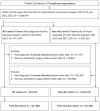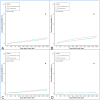The Relationship Between Aortic Stenosis and the Possibility of Subsequent Macular Diseases: A Nationwide Database Study
- PMID: 40150102
- PMCID: PMC11941305
- DOI: 10.3390/diagnostics15060760
The Relationship Between Aortic Stenosis and the Possibility of Subsequent Macular Diseases: A Nationwide Database Study
Abstract
Objectives: This study aimed to investigate the possible relationship between aortic stenosis (AS) occupancy and the incidence of subsequent macular diseases. Methods: A retrospective cohort study was conducted using the TriNetX database, and participants with AS were enrolled and matched to non-AS participants. A total of 421,860 and 421,860 participants were evenly divided into the AS and non-AS groups, respectively. The major outcomes of the present study include the development of age-related macular degeneration (AMD), retinal vascular occlusion (RVO), epiretinal membrane (ERM), and central serous chorioretinopathy (CSC). Cox proportional hazard regression was utilized for statistical analysis. Results: There were 4426 and 3013 AMD events; 7315 and 4753 RVO events; 2780 and 1910 ERM events; and 113 and 64 CSC events in the AS and non-AS groups, respectively. According to the results of Cox proportional hazard regression analysis, the AS group demonstrated significantly higher incidences of all macular diseases, including AMD, RVO, ERM, and CSC, compared to the non-AS group (all p < 0.05). The cumulative probabilities of all macular diseases were significantly higher in the AS group than in the non-AS group (all p < 0.05). In the sensitivity analysis, the developmental risks of AMD were significantly higher in the AS group than in the non-AS group with all traits. Conclusions: This study determined that AS occupancy is related to a higher risk of developing macular diseases, which positively correlated to the disease time of AS.
Keywords: TriNetX database; age-related macular degeneration; aortic stenosis; epidemiology; retinal vascular occlusion.
Conflict of interest statement
The authors declare no conflicts of interest.
Figures






Similar articles
-
RISK OF EXUDATIVE AGE-RELATED MACULAR DEGENERATION IN PATIENTS WITH CENTRAL SEROUS CHORIORETINOPATHY: A Nationwide Cohort Study.Retina. 2022 May 1;42(5):852-858. doi: 10.1097/IAE.0000000000003412. Retina. 2022. PMID: 35067609
-
Morphologic features of large choroidal vessel layer: age-related macular degeneration, polypoidal choroidal vasculopathy, and central serous chorioretinopathy.Graefes Arch Clin Exp Ophthalmol. 2018 Dec;256(12):2309-2317. doi: 10.1007/s00417-018-4143-1. Epub 2018 Sep 27. Graefes Arch Clin Exp Ophthalmol. 2018. PMID: 30259090 Review.
-
The risk of retinal vein occlusion among patients with neovascular age related macular degeneration: a large-scale cohort study.Eye (Lond). 2023 May;37(7):1445-1450. doi: 10.1038/s41433-022-02163-7. Epub 2022 Jul 1. Eye (Lond). 2023. PMID: 35778605 Free PMC article.
-
The Changes of Irisin and Inflammatory Cytokines in the Age-Related Macular Degeneration and Retinal Vein Occlusion.Front Endocrinol (Lausanne). 2022 Mar 17;13:861757. doi: 10.3389/fendo.2022.861757. eCollection 2022. Front Endocrinol (Lausanne). 2022. PMID: 35370941 Free PMC article.
-
Hypothetical pathogenesis of age-related macular degeneration and pachychoroid diseases derived from their genetic characteristics.Jpn J Ophthalmol. 2020 Nov;64(6):555-567. doi: 10.1007/s10384-020-00773-w. Epub 2020 Oct 2. Jpn J Ophthalmol. 2020. PMID: 33006732 Review.
References
-
- Phillips D. Aortic stenosis: A review. Aana J. 2006;74:309–315. - PubMed
LinkOut - more resources
Full Text Sources
Research Materials

